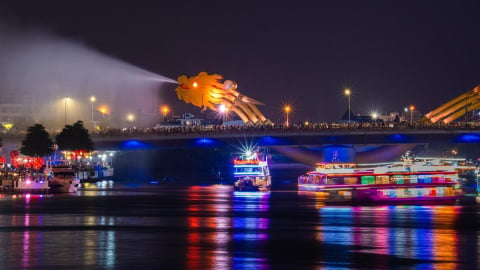To be able to plant on barren land, to retain water, to suit the mountainous terrain, terraced fields are an ideal solution. This is also a familiar image of agriculture in many countries around the world. The fields are built by hand, requiring people to spend a huge amount of effort.
These terraced fields not only bring a more prosperous life to the people in the mountainous areas but are also increasingly known as a wonderful “artificial” landscape. These fields have now become a tourist attraction, a “holy land” that any photographer would like to capture with their lens breathtakingly beautiful frames.
Terraced fields in Sa Pa, Vietnam
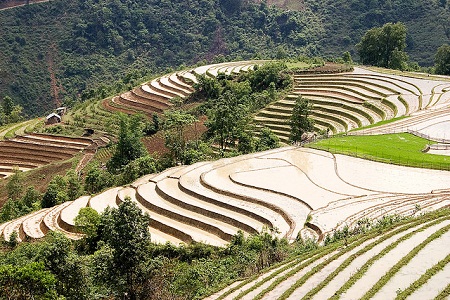
In this northern mountainous town, terraced fields are part of the reason why tourists trek over mountain passes and endure a long and arduous journey to see with their own eyes the gently undulating fields that stretch across the hillsides.

The rice fields have different beauty at different times: when the fields are flooded, when the rice is green, when the rice is ripe and golden... At different times of visit, visitors will admire completely different beauties.

Sa Pa is also home to many ethnic minorities, creating a cultural region that is especially attractive to tourists, allowing them to freely explore the unique beauty of Sa Pa.
In October 2013, the Ministry of Culture, Sports and Tourism decided to rank SaPa terraced fields as a national scenic relic.
Rice terraces in Pisac, Peru
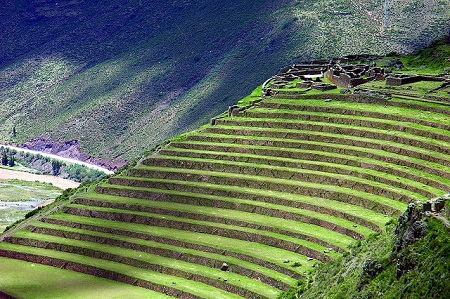
The terraced fields of Pisac have been around for hundreds of years and are still used by Peruvian farmers to this day. This was once a stronghold of the Inca Empire that existed from the 15th to 16th centuries.
On the terraced fields in Pisac, one can still see the presence of many historical vestiges, with ramparts, temples, ancient houses... spread throughout the village of Pisac located in the Valley of the Gods.
Terraced fields in Douro, Portugal

The land of port wine, the Douro Valley in northern Portugal, is home to terraced vineyards. The Douro landscape changes throughout the year as the vines change colour. The Douro is said to be at its most beautiful in autumn, when the grapes turn red all over the hills.
Rice terraces in Bali, Indonesia

The gently sloping rice terraces in Bali appear everywhere, the culture of the people living on the island of Bali is also closely linked to the agricultural civilization on these 2,000-year-old rice terraces.
Rice terraces in Choquequirao, Peru

Choquequirao is an ancient ruined city that existed during the Inca Empire, located in Southern Peru. Choquequirao also means “Golden Cradle”. Located at an altitude of 3,085m above sea level, Choquequirao has a total of 180 terraced fields.
Although often compared to the more famous historical site – Machu Picchu – Choquequirao is much larger. The ancient city can be explored on foot or by horseback.
The road here is not open to motor vehicles. The hike up to Choquequirao can take up to 4 days.
Salt terraces in Maras, Peru

The salt fields in Maras have been around for hundreds of years, dating back to the Inca Empire in the 15th and 16th centuries. To this day, people still use these terraced fields to produce salt. Locals often channel natural streams from the mountains, which contain a very high salt content, into these terraced tanks.
There are 3,000 such tanks in the salt field. When the water evaporates under the sun, it leaves salt in the tanks. People then peel these salt blocks from the tanks and take them to the market to sell. The Maras salt field is most beautiful at dusk, when the sunlight reflects off the tanks, making the salt field look like a sea of gold.
Rice terraces in Ollantaytambo, Peru

During the Inca Empire, Ollantaytambo was home to the rulers of the empire. At that time, Ollantaytambo was a stronghold of the Inca Empire, where it always produced bountiful harvests.
Now, this place has become a historical tourist attraction, attracting a lot of tourists. It is no longer a rich agricultural land but the terraced fields are still there, giving people the image of a strong and powerful ancient Empire.
Rice terraces at Machu Picchu, Peru
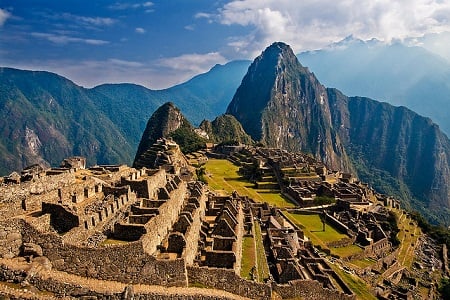
Machu Picchu is one of the most ancient, beautiful and impressive sites in the world. Machu Picchu lay hidden for centuries in the Urubamba Valley. The lost city of the Inca Empire is invisible from the valley floor.
Once a rich agricultural area, Machu Picchu was home to terraced fields that ran across the hillsides. Machu Picchu had narrow fields built of stone blocks. Now, these fields are completely abandoned, but the ruins that remain are enough to show the feat of construction of the ancient people.
Terraced fields in Longsheng, China
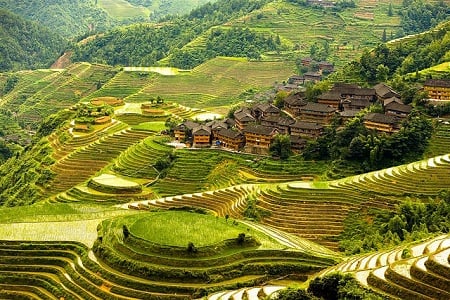
The 500-year-old terraced fields in Long Thang town are also called “the dragon’s spine” by locals because the fields are stacked on top of each other, stretching as far as the eye can see, giving people the impression of a giant spine.
Terraced fields in Honghe, China
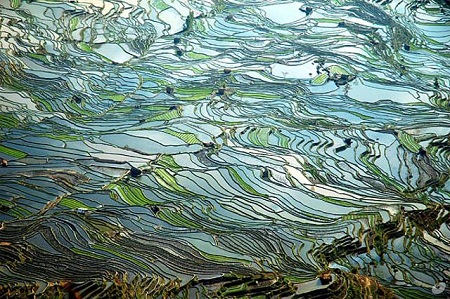
The Hani terraced fields in Honghe County, Yunnan Province, China are 1,000 years old. In addition to growing food crops, people also raise fish in these fields.
Coming to Hong Ha from December of the previous year to about March of the following year, visitors will see the magical scene when the fields have been filled with water. Every time the sunset falls, the scene shimmers, brilliantly and magically.
Rice terraces in Banaue, Philippines
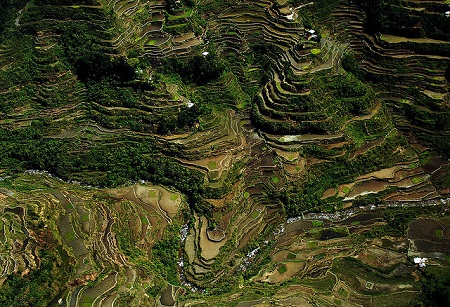
Located in the mountains, the Banaue municipality of the Philippines is 1,525m above sea level. With its mountainous terrain, the ancient inhabitants here used human power to create terraced fields more than 2,000 years ago.
These fields are so steep that it has been estimated that if these fields were to run end to end, they would travel halfway around the world. Nowadays, people in Banaue tend to go to the city to find work, and the terraced fields here are gradually abandoned without anyone to care for them.



























